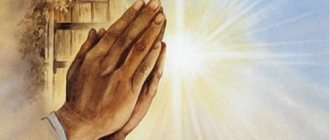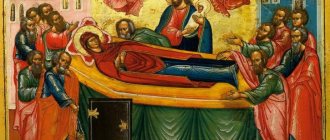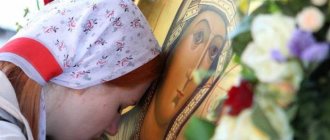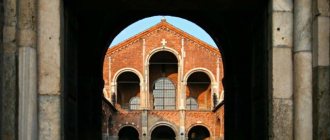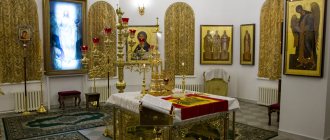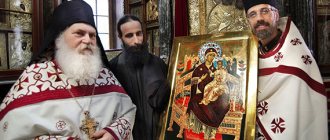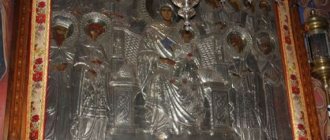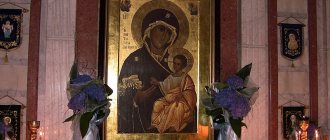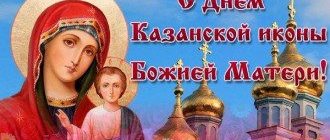History of the icon
According to the descriptions, on this icon the Mother of God is depicted in a small profile, with a baby in her left hand and a mountain with a temple in her right.
Why is the icon called “Fat Mountain”? The word “fat” was well understood by our ancestors, but now it is outdated and not many people know its meaning. Fat means full, and in a figurative word - abundant, generous.
The history of the icon of the Mother of God “Fat Mountain” dates back to the 17th century. It was presented by the abbot of one of the monasteries to a resident of Tver, Kosma Volchaninov, for his good work - he was renovating the monastery.
The image was kept in his family for several decades, but eventually ended up in the attic. He was found under unusual circumstances: an angel told his wife about the whereabouts of his great-grandson Kosma.
Over time, the icon became one of the most revered in Tver: people from all over the area came to pray to it. Over the course of three pre-revolutionary centuries, the icon of the Mother of God “Fat Mountain” repeatedly showed numerous miracles.
Icon of the Mother of God “Fat Mountain”. Graceful power
The Icon of the Mother of God “Fat Mountain” is now not mentioned very often, although it used to be widely known. The image has another name - “Insectless”, which is associated with the deep meaning inherent in it, which is expressed in a huge number of different interpretations and descriptions of this image of the Virgin Mary.
What do they pray to the “Fat Mountain” icon for, and how does it help?
• First of all, they pray to the icon for children; • about the conversion of the lost to the Orthodox faith; • about enlightenment of the mind; • about restoring peace in the family or relationships; • on protection from natural disasters; • about patronage in difficult matters.
Prayer to the Blessed Virgin Mary before her image “Fat Mountain”
To You, Lady, before Your icon, bowing my proud neck in tenderness, I cry out: Behold, I, a sinner, have been called from the one who bears to the Being, but soon for my countless and vile sins I will again be turned into the one who carries to the abysses of hell; but from the darkness of the stinking sins of my sins I pray to You, Offering: save me, beg Your Son to wait again, so that a vain death will not devour me today, and that by His great mercy and with Your favorable, Most Pure, help, I will turn from darkness to Light, from self-love to God-love, from unbelief to faith, from evil to good, from the abomination of sin to reverence; If it is impossible for man to happen, then it is possible for God, and from now on I will serve to glorify Your Son, surrendering to his all-good will, so that I too may come at the Last Judgment of Christ to His good and beloved sheep to pasture for everlasting joy and life. Amen.
APRIL 6Icon of the Mother of God “Fat Mountain”
***
About 250–300 years ago, this icon was in one of the monasteries of Tver and was presented by the abbot to Cosma Volchaninov in gratitude for the well-performed work in the monastery church. This icon was passed down from generation to generation as a shrine, but one irreverent grandson of Cosmas took the dilapidated icon into the attic. His daughter-in-law suffered many insults from her husband and his relatives. In despair, the woman decided to commit suicide in an empty bathhouse. On the way, a monk appeared to her and said: “Where are you going, unfortunate one? Go back; go, pray to the Mother of God of the Fat Mountain - and you will live well and peacefully.” The excited young woman, returning home, told everything, without hiding her criminal intentions. They began to look for the monk, but did not find him, no one except her saw him. This happened on the eve of the Feast of the Annunciation of the Blessed Virgin Mary. The icon was immediately found in the attic, cleaned of dirt and placed in a place of honor in the house. In the evening, the parish priest was invited, who performed an all-night vigil before the icon, which since then has been celebrated in the house every year on this day. For more than a hundred and fifty years, the icon was in the Volchaninov family. Ekaterina, the daughter of Vasily, the last of the Volchaninov family, having married Georgy Ivanovich Konyaev, took to herself the icon of the Mother of God as her most precious inheritance. And in Konyaev’s house, prayers and all-night vigils were held in front of this icon on March 24 and November 7 (probably this was the day the icon was transferred from the monastery to the house of Kosma Volchaninov).
In 1863, at the cemetery church of the Smolensk Icon of the Mother of God, it was decided to build a chapel in honor of St. Tikhon and St. Macarius of Kalyazin. The then owner of the icon, Georgy Konyaev († 1868, at the age of 97 years) wished to transfer the celibate image of the Mother of God to the temple. He turned to the clergy with a request to build another chapel for the miraculous image of the Mother of God “Fat Mountain”. At the same time, he said: “I consider the temple of the Smolensk Icon of the Mother of God the best for her, because the place on which the church was built was in the old days called a mountain, as the highest place in the city. In the past, residents brought their property to this mountain during floods and saved themselves from death here. May the Queen of Heaven – the Fat Mountain – rest with her grace on this mountain and cover all those buried here with her mercy.” On July 15, 1866, the icon was moved to the built chapel, which the next day was consecrated by Bishop Anthony of Staritsa.
On the icon, the Most Holy Theotokos is depicted standing on a semicircular elevation - a mountain; on Her left hand is the Child of God with a blessing right hand. On the head of the Mother of God is a crown, and in her hand is a small mountain, on which the top of the church with domes and crosses is visible.
***
Prayer to the Most Holy Theotokos
Oh, our all-merciful Lady, Most Holy Theotokos Mary! Look upon us, Thy perishing servants, before we are vile, before we are prodigal, before we are slanderers, and above all proud, but now we have seen all our abomination before the eyes of the Lord and are no longer worthy to appear before His face, and only to Thee, the Lady, as we call upon our most merciful Intercessor. O Mother of God, do not leave us in our sins. Our undoubted hope, renew us in repentance, raise us to fulfill the commandments of God, teach us in the Church of Saints and make us worthy of Holy Communion of the Life-Giving and Divine and Terrible Mysteries; You constantly pray for us, Your Son and God, we know how much motherly prayer can do. And may you ask Christ God for our bodily health, and as the merciful one, the grace of our souls, send peace and good haste to all our neighbors, look upon our city, protected by Your protection, and show it a speedy intercession from Your miraculous and beautiful holy icon, even now we are grateful We kiss, and save him and all other cities and towns and the entire Orthodox family from all vain disasters; and repel the invasion of heresies from the tongues of foreigners that come upon us, schisms, devastation, strife and other divisions in the Church of God, as with Thy healing oil, anointed with unfeigned love, reliably rule, so that a peaceful and pious life will be our inheritance, and may we be honored with good words from To hear Thy Son and our Judge under His right Judgment, to Him be glory and honor and worship with His beginningless Father and His All-Graceful Spirit, now and ever and unto the ages of ages. Amen.
Source: azbyka.ru
***
Dear friends, if you need spiritual support, you can order prayer help for yourself, family and friends in our church:
Light a candle Order a prayer service for health Sorokoust for health Remembrance for the year
In the Assumption Cathedral in Yekaterinburg, services are held every day.
Our address:
Ekaterinburg, st.
Kirova, 65 You can ask all questions by phone
8-908-923-05-04 (available WhatsApp, Viber, Telegram)
Email address:
Icon of the Mother of God "Fat Mountain"
About 250 - 300 years ago, this icon was in one of the monasteries of Tver and was presented by the abbot to Cosma Volchaninov in gratitude for the well-performed work in the monastery church. This icon was passed down from generation to generation as a shrine, but one irreverent grandson of Cosmas took the dilapidated icon into the attic. His daughter-in-law suffered many insults from her husband and his relatives. In despair, the woman decided to commit suicide in an empty bathhouse. On the way, a monk appeared to her and said: “Where are you going, unfortunate one? Go back; go, pray to the Mother of God of the Fat Mountain - and you will live well and peacefully.” The excited young woman, returning home, told everything, without hiding her criminal intentions. They began to look for the monk, but did not find him, no one except her saw him. This happened on the eve of the Feast of the Annunciation of the Blessed Virgin Mary. The icon was immediately found in the attic, cleaned of dirt and placed in a place of honor in the house. In the evening, the parish priest was invited, who performed an all-night vigil before the icon, which since then has been celebrated in the house every year on this day. For more than a hundred and fifty years, the icon was in the Volchaninov family. Ekaterina, the daughter of Vasily, the last of the Volchaninov family, having married Georgy Ivanovich Konyaev, took to herself the icon of the Mother of God as her most precious inheritance. And in Konyaev’s house, prayers and all-night vigils were held in front of this icon on March 24 and November 7 (probably this was the day the icon was transferred from the monastery to the house of Kosma Volchaninov).
In 1863, at the cemetery church of the Smolensk Icon of the Mother of God, it was decided to build a chapel in honor of St. Tikhon and St. Macarius of Kalyazin. The then owner of the icon, Georgy Konyaev (+ 1868, at the age of 97 years) wished to transfer the celibate image of the Mother of God to the temple. He turned to the clergy with a request to build another chapel for the miraculous image of the Mother of God “Fat Mountain”. At the same time, he said: “I consider the temple of the Smolensk Icon of the Mother of God the best for her, because the place on which the church was built was in the old days called a mountain, as the highest place in the city. In the past, residents brought their property to this mountain during floods and saved themselves from death here. May the Queen of Heaven, the Fat Mountain, rest with her grace on this mountain and cover all those buried here with her mercy.” On July 15, 1866, the icon was moved to the built chapel, which the next day was consecrated by Bishop Anthony of Staritsa.
On the icon, the Most Holy Theotokos is depicted standing on a semicircular elevation - a mountain; on Her left hand is the Infant God with a blessing right hand. On the head of the Mother of God is a crown, and in her hand is a small mountain, on which the top of the church with domes and crosses is visible.
Unfortunately, after the closure of the Smolensk Church, the icon disappeared. But the memory of the “Fat Mountain” icon did not disappear. With the blessing of Archbishop Viktor of Tver and Kashinsky, in 1993 a list of the “Fat Mountain” icon was written and the solemn veneration of this icon was resumed. Memory of St. The “Fat Mountain” icon of the Mother of God is celebrated three times: on July 16 in honor of the consecration of the throne, on March 24 in honor of the first miracle from the icon, and on November 7 according to ancient custom. The now revered copy of the icon is in the Ascension Cathedral in Tver.
Celebration: March 24 (April 6), July 16 (July 29), November 7 (November 20).
Akathist to the Mother of God before the icon of Her “Fat Mountain”
Icon of the Mother of God “Fat Mountain”. Experience of contemplation
And dreams flee, and the truth is laid bare.
A simple crossbar.
The last sign of the last sheet, -
And the book of life in eternity closed.
(mother Maria (Skobtsova))
The Youth King in a crimson and gold himation, with a patrician clave on a tunic white as snow (Mark 9:3), sits as a Judge.
In the shuyts, the left hand of the Youth, there is a scroll from which all the seals will soon be removed. The youth looks at the ground on which His Church stands.
“Behold, the whole earth is inhabited and silent” (Zech. 1:11)
The scroll is tied four times, for in the four corners of the universe, the inhabited and inhabited earth, the Gospel of the Son of God was preached.
The features of the folds of the girdle adjacent to the shuytsa of the Judge and the Youth, the Son of God, form the figure of a sickle. The Day of the Lord has come, the Day of the last harvest... The Lord of the harvest (Matthew 9:38) looks upon the earth.
“And I turned and lifted up my eyes, and saw, and behold, a sickle flying.” (Zechariah 5:1)
– writes one of the last prophets of Israel, Zechariah, who wrote about God’s judgment over Israel and the nations.
His harvest is the end of the age (Matthew 13:39), the end of the earthly and immersed in corruption of the world, which melts from the face of God, from the face of Christ, for the “bright fire” of His Divinity, piercing His human Flesh, shines with a new dawn over the tired and decrepit world.
And the himation of the Son of Man, the Son of Mary, burns with divine gold, through which the scarlet color of His blood appears - illuminate us with the bright fire of the Divine! (Irmos of the 7th song of the Sunday canon, 3rd tone)
The Mountain of God, embodied in the image of the slender, towering figure of the Mother of God, is a biblical symbol of the Church of God, which, according to the word of the prophet Isaiah, will reveal the light of Emmanuel to all the peoples of the earth.
“And it shall come to pass in the last days, that the mountain of the house of the Lord shall be established as the top of the mountains, and shall be exalted above the hills, and all nations shall flow unto it” (Isaiah 2:2)
The image of Isaiah is revealed in the icon twice - both in the very image of the Mother of God, holding the Son of God, who came to Zion, His holy mountain, and in the image of the temple of God, which stands on the rock of the Spirit.
The right hand of the Mother of God carefully holds this uncut stone (Dan. 2:44), crowned with the Cross of Her Son - holds it opposite the Child Himself, who sits on Her right hand. The Rock is a symbol of the Spirit operating in the Risen Christ (Rom. 8:11; 1 Peter 3:19) and living in the Church of Christ.
The Prophet Zechariah, who spoke in his book about numerous visions revealed to him during the construction of the Second Temple, during the return of the Old Testament Church from the Babylonian captivity, utters the words repeated by Jesus Christ in the darkness of the Gethsemane night, and the words with which the Evangelists will describe the Passion of Christ:
“And I will say to them: if it pleases you, then give Me My wages; if not, don’t give it; and they will pay me thirty pieces of silver (Zech. 11:12); “Strike the shepherd, and the sheep will be scattered!” And I will turn my hand against the little ones” (Zech. 13:7); “They will look at Him, whom they have pierced, and will mourn for Him, as one mourns for an only begotten son, and mourns, as one mourns for a firstborn” (Zech. 12:10); And it will happen on that day: there will be no light, the luminaries will be removed (Zech. 14:6).
All these prophecies were usually attributed to the Day of the Lord, the Day of Judgment and the Triumph of God.
The Old Testament church prepared for the Day of the Lord in order to meet it worthily, as it seemed to believers at that time. The strictness of fasting, the fulfillment of the requirements of the Law...
And against this background the prophet’s denunciation sounds:
“And when you eat and when you drink, do you not eat for yourselves, do you not drink for yourselves?... execute fair judgment and show mercy and compassion every one to his brother; Do not oppress the widow and the orphan, the stranger or the poor, and do not think evil against one another in your hearts (Zech. 7:6;9-10).
Yes, this is how Christ will judge people -
“Come, you blessed of My Father, inherit the kingdom prepared for you from the foundation of the world. Because I was hungry (I was hungry), and you gave Me food; I was thirsty and you gave Me something to drink; I was a stranger and you accepted Me; I was naked and you clothed Me; I was sick and you visited Me; I was in prison, and you came to Me” (Matthew 25:34-36).
Metropolitan Anthony of Sourozh said in one of his sermons dedicated to these words of Christ:
“Were you humane on earth? When you were faced with grief, did you think about how to console? When there was hunger, and cold, and melancholy, and abandonment, and imprisonment, and captivity of illness - what did you do: did you regret it or not?
He is the Good Judge, He is the Shepherd, who came to the poor in spirit, and not to the righteous “who have fulfilled all the commandments”:
“And I will feed the sheep doomed to the slaughter, the poor sheep indeed” (Zech. 11:7).
They will share His Cross with Him, and will not try to buy the Kingdom from Him with their “righteous” deeds. And they recognize Him by touching the wounds of the nails in His hands...
“And I will bring this third part into the fire, and will refine them as silver is refined, and will refine them as gold is refined: they will call on My name, and I will hear them and say, “These are My people,” and they will say, “Lord.” - My God!" (Zech. 13:9)
It is no coincidence that the rock with the church crowned with a cross in the hand of the Mother of God also resembles broken bread - for in the Sacrament of the Eucharist the Son of God comes to the earth frozen in silence.
Let all the earth be silent before Him (Hab. 2:20)
On Holy Saturday, the hymn repeats these words of the prophet, showing their new, boundless depth:
Let all human flesh remain silent and stand with fear and trembling, and let nothing earthly think within itself: the King of kings and Lord of lords comes to sacrifice and be given as food to the faithful.
(Let all flesh be silent and stand with fear and trembling, not thinking about anything earthly: for the King of kings and Lord of lords comes to be slain and give Himself as food to the faithful).
Christ blesses the Church on the rock of the Spirit, blesses the Bread, which He Himself brings, like a Priest, in this Church.
And His feet will stand in that day on the Mount of Olives, which is in front of Jerusalem to the east (Zech. 14:4)
The fat mountain, the mountain on which the rain fell, is a vivid image of Psalm 67 (vv. 16-17).
St. Athanasius the Great spoke about this psalm:
“In this psalm the prophet depicts the coming of the Lord, the overthrow of mental enemies and the end of spiritual captivity; and also teaches that the Lord is the One who brought the children of Israel out of Egypt of old. In addition to this, the sermon promises the gift of the Holy Spirit to those who receive it, and adds consolation to the Apostles with the promise of deliverance from all sorrow that befell them for preaching.”
In some depictions of the icon, in the folds of the Baby’s robe, one can discern the outline of a cup, from which, from His womb, streams of the living water promised by Christ in the Gospel flow in streams of golden himation (John 7:38).
Story
Around the 17th century, the location of the icon was one of the Tver monasteries for men. From there, it was transferred as a gift from the abbot to Cosma Volchaninov for the good performance of the duties undertaken to carry out the repairs. The volume of work performed was significantly greater than what was previously agreed upon, and everything was done with high quality, conscientiously.
Volchaninov was asked to choose for himself which of the holy faces he would prefer to take. The contractor decided that he would take away the icon of the Mother of God located in the left cathedral choir. Apparently, it was located there “behind the excess” and stood directly on the floor.
Cosmas himself treated the gift as the greatest shrine, which he revered throughout his life. The iconographic face was passed on to each subsequent generation with reverent awe, until it ended up in the hands of one of Cosmas’ grandsons, who was not distinguished for diligence in the faith. He threw the image into the attic and forgot to think about it.
This grandson was married and Cosma’s daughter-in-law was constantly subjected to bullying and insults from her husband and his relatives. In the end, the desperate woman left the house, heading to an empty bathhouse, where she wanted to commit suicide.
Suddenly she met a stranger. Judging by his robes, he was a monk. The man turned to the woman, asking where she was going, and then told her to return to the house and pray before the icon of the Mother of God “Fat Mountain”. The monk promised that thanks to this, her life would become calm and good.
The astonished daughter-in-law of Cosma returned to the house and told about everything that had happened, including her intention to take her own life. Everyone rushed to look for the monk, but it turned out that no one had seen him.
This happened on the eve of the celebration of the Annunciation of the Blessed Virgin Mary. The icon was immediately removed from the attic, cleaned and placed in a place of honor. In the evening, the parish priest who had been invited earlier arrived. He performed an all-night vigil in front of the icon, which was then repeated on the same day every year, and life in the family has really improved since then.
After this event, the icon was kept by the Volchaninov family for more than 150 years. And then, together with the daughter of the last representative of the family, she passed into the Konyaev family, as the greatest legacy. the icon of the Mother of God “Fat Mountain” twice a year (March 24 and November 7) .
In the second half of the 19th century, it was planned to expand the Tver Church, dedicated to the Smolensk Icon of the Mother of God, in the form of a new chapel in honor of St. Tikhon and St. Macarius of Kalyazin. At that time, the icon belonged to Georgy Konyaev, who had reached the venerable age of 97 years. He knew that Kosma Volchaninov bequeathed to transfer the “Fat Mountain” to the temple when the male line of his family was interrupted. The last in the family was Yegor’s wife, Ekaterina. She and her husband thought for a very long time about where exactly to give the image of the Mother of God, but could not make a final decision.
George decided that it was necessary to place the image of the Mother of God in the temple, but asked to arrange a separate chapel for it, adding that he considered the temple dedicated to the Smolensk Icon of the Mother of God to be the best place for the image. The reason for this was the fact that the church is located on a place previously called a mountain, since it was the highest within the city. This elevation served as a place of salvation for people and their property during floods. “Let the Queen of Heaven “Fat Mountain” rest Her grace on this mountain,” added the elder and the clergy accepted his request.
The icon was moved to the new chapel on July 15, 1866, for the consecration of which Bishop Anthony of Staritsky arrived a day later. Unfortunately, during the revolution, the Smolensk Church was closed and the icon was lost. But the memory of her remained. In 1993, a list of the image was created, and her veneration continued.
What to pray for
Prayer before the icon of the Mother of God “Fat Mountain” can help those who need:
- gain peace of mind, calm the tossing of the spirit;
- convert (return) the lost;
- restore peace, love and mutual understanding in your home, family or relationships;
- protection from natural disasters and patronage in difficult matters;
- heal a sick child from physical and mental illnesses.
To address her, you can use a special prayer, or you can speak in words coming from the heart, but the main thing is to do this with deep faith.
The icon has three days of veneration:
- July 29/16 (new/old style) - the date of the consecration of the chapel of the Tver Smolensk Church (now destroyed) erected in honor of the icon;
- April 6/March 24 – mention of the first miracle revealed by the face of the Mother of God; in honor of this event, annual all-night vigils are held in his honor;
- November 20/7 is the day when the image was presented to Volchaninov and moved from the monastery monastery to the house of Cosmas.
These holidays are observed with special care, of course, in Tver, where the original icon was kept for so long, and now two copies of it are located.
Graceful power
During the three centuries before the revolution, the icon of the Mother of God “Fat Mountain” often demonstrated its miraculous power. Pious citizens took her into their homes for a while to heal their children. The copies from this face of the Mother of God also had a beneficial effect.
One of the rectors of the Smolensk Church, John the Theologian, recalled that as a child he suffered from severe eye pain. During the next attack, his mother brought the child to the icon and anointed him with oil from the lamp hanging in front of her. Each time the pain receded, and then stopped appearing altogether.
Description and meaning
Pre-revolutionary sources contained a short description of this Virgin Mary face. Its dimensions were 11 inches in height and 12 inches in width (49x54 cm)
The icon of the Mother of God “Fat Mountain” depicts the Blessed Virgin in a small profile. The Mother of God holds the Divine Infant with her left hand, holds her head tilted slightly to the right, and looks at the one who is looking at the icon.
Externally, the face of the Mother of God is very harmonious and proportional. Her entire pose, including tilting and turning her head, exudes chastity. In fact, the Virgin’s eyes are turned simultaneously to both the person praying and the five-domed Orthodox church located in her palm.
This is an interesting icon paradox, when the image performs both artistic and ecclesiastical functions, giving the feeling that the Mother of God not only listens, but also participates in prayer, conducting a silent conversation with the one asking.
The Savior's right hand is raised in a blessing gesture. The forehead of the Mother of God is crowned with a crown, and in her right hand rests a small mountain with a church standing on top of it. Temple domes with golden crosses can be seen.
The very figure of the Blessed Virgin here is also an image of the Mountain of God (otherwise, the Church of God), which, in accordance with the words of the prophet Isaiah, should reveal the light of Emmanuel to all the people of the earth. The exaltation located in her palm is called the uncut (whole, fat) rock of the Spirit, with which the resurrected Jesus was filled and which lives in the Church of Christ.
The same rock symbolizes the idea of the Savior in the form of a stone that fell from a large mountain and turned Golden Babylon into ruins. This is Daniel's comparison used in interpreting Nebuchadnezzar's dream.
With God's help, the prophet explained to the king that the colossus that appeared to him with a golden head, a silver (and also filled with other metals) body and clay feet was the world in which they lived. The head of gold represents Babylon at its peak.
But according to God’s plan, there should be no other kingdoms left on earth except the one kingdom of God, which no one will be able to overcome, and the Stone-Jesus “without hands,” separated from the fat mountain (the Mother of God), will help bring this plan to life.
The integrity of the mountain in the image suggests that the Stone has not yet been torn away from it and has not fallen on the world, and the Christian Church and faith still rest firmly on its top.
Some engravings of the icon display an interesting detail: the folds of the Savior’s robe form a cup filled from the womb of the Infant God. The living water, which Christ promised according to the Gospel, flows out like streams of golden fabric.
The name of the icon comes from the 67th Psalm, which speaks of the fruitful Mountain of God, which was watered by the rain of the Spirit.
